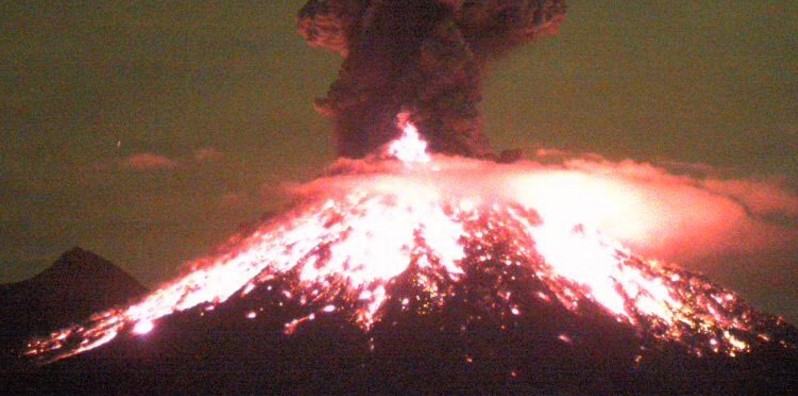Very strong explosion at Colima volcano, Mexico

After three moderate to large explosions over the past 10 days, Mexico's Colima volcano experienced another strong explosion at 06:27 UTC (00:27 CST) on January 18, 2017. The eruption spewed volcanic ash up to 4 km (13 123 feet) above the crater. Ashfall was reported in Zapotlan and Jalisco.
Due to increased activity of the volcano in recent days, Mexican National Civil Protection System has warned the population that persistent and strong ashfall is expected and urged them to take necessary precautions and stay alert to official information. Even light ash fall can contaminate drinking water and food containers, they warned.
#PorSiNoViste la explosión del @Volcan_Colima (00:27 h). Fragmentos incandescentes en todo el edificio volcánico y flujos piroclásticos. pic.twitter.com/PxqUtew63q
— SkyAlert (@SkyAlertMx) January 18, 2017
#Ahora – Intensa explosión del @Volcan_Colima – 00:27 h. Fragmentos incandescentes sobre todo el edificio volcánico y columna eruptiva +4km. pic.twitter.com/xD7cFBarTl
— SkyAlert (@SkyAlertMx) January 18, 2017
Se reporta ceniza en Zapotlán el Grande (Cd. Guzmán), Jalisco, por explosión durante la madrugada del #VolcánDeColima.
Foto @Excelsior pic.twitter.com/NJT0K0d41G— SkyAlert (@SkyAlertMx) January 18, 2017
Earlier, the agency warned nearby residents to limit their outdoor activity, keep the windows and doors closed, protect eyes, nose, and mouth. If possible, use a damp cloth, wash it regularly and wear protective glasses. If you have to go out, try wearing long-sleeved clothing and a hat. Do not drive if possible, but if you have to, do so at a low speed and with the lights on. Remember that ash damages the engines and the performance of vehicles. People with asthma and respiratory problems should not be exposed to ash.
Cover your water and food containers, both human and animal, and do not allow ash to accumulate on ceilings, roofs, patios, and streets. Store your important documents in a plastic bag and have the emergency backpack at hand. Always remember to carry out your Family Protection Plan.
In recent days, Colima experienced three moderate to large explosions (on January 7, 8 and 12), two of which generated shock waves and ash fall detected up to the municipality of Ixtlahuacán. Estimated heights reached up to 7 km (23 000 feet) above the crater (10.8 km / 35 433 feet above sea level). The explosion on Sunday, January 8, generated a pyroclastic flow on the eastern slope of the volcano that descended up to 4 km (2.5 miles).
Based on the activity recorded over the past several days, the agency established an 8 km (5 miles) exclusion zone around the volcano.



Geological summary
The Colima volcanic complex is the most prominent volcanic center of the western Mexican Volcanic Belt. It consists of two southward-younging volcanoes, Nevado de Colima (the 4320 m high point of the complex) on the north and the 3850-m-high historically active Volcán de Colima at the south. A group of cinder cones of late-Pleistocene age is located on the floor of the Colima graben west and east of the Colima complex. Volcán de Colima (also known as Volcán Fuego) is a youthful stratovolcano constructed within a 5-km-wide caldera, breached to the south, that has been the source of large debris avalanches.
Major slope failures have occurred repeatedly from both the Nevado and Colima cones, and have produced a thick apron of debris-avalanche deposits on three sides of the complex. Frequent historical eruptions date back to the 16th century. Occasional major explosive eruptions (most recently in 1913) have destroyed the summit and left a deep, steep-sided crater that was slowly refilled and then overtopped by lava dome growth. (GVP)
Featured image: Eruption of Mexico's Colima volcano on January 18, 2017. Credit: WebcamsDeMexico

This eruption think is related with the X-Flare from the Sun, same day, 01/18/2017. Neutrinos got underneath earth, and we need to watch that volcano as well as others that can as this one, suddenly become active.